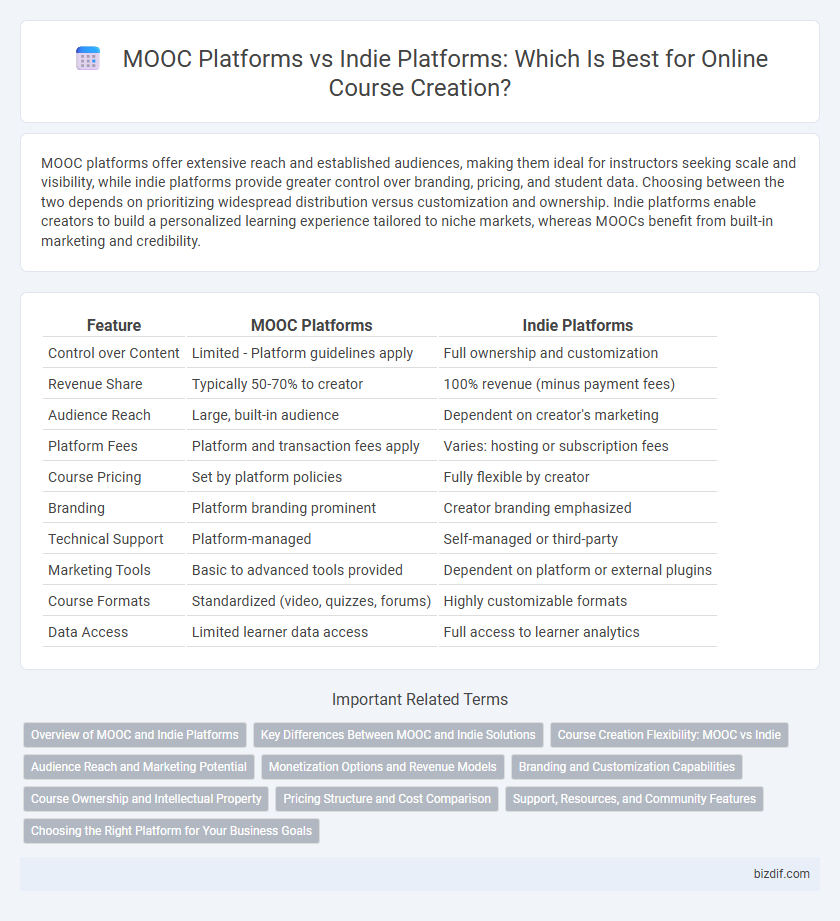MOOC platforms offer extensive reach and established audiences, making them ideal for instructors seeking scale and visibility, while indie platforms provide greater control over branding, pricing, and student data. Choosing between the two depends on prioritizing widespread distribution versus customization and ownership. Indie platforms enable creators to build a personalized learning experience tailored to niche markets, whereas MOOCs benefit from built-in marketing and credibility.
Table of Comparison
| Feature | MOOC Platforms | Indie Platforms |
|---|---|---|
| Control over Content | Limited - Platform guidelines apply | Full ownership and customization |
| Revenue Share | Typically 50-70% to creator | 100% revenue (minus payment fees) |
| Audience Reach | Large, built-in audience | Dependent on creator's marketing |
| Platform Fees | Platform and transaction fees apply | Varies: hosting or subscription fees |
| Course Pricing | Set by platform policies | Fully flexible by creator |
| Branding | Platform branding prominent | Creator branding emphasized |
| Technical Support | Platform-managed | Self-managed or third-party |
| Marketing Tools | Basic to advanced tools provided | Dependent on platform or external plugins |
| Course Formats | Standardized (video, quizzes, forums) | Highly customizable formats |
| Data Access | Limited learner data access | Full access to learner analytics |
Overview of MOOC and Indie Platforms
MOOC platforms such as Coursera, edX, and Udacity offer large-scale, structured courses from universities and institutions, providing wide reach and established credibility. Indie platforms like Teachable, Kajabi, and Podia empower creators with customizable tools, direct monetization, and greater control over branding and student engagement. Choosing between MOOC and Indie platforms depends on the desired audience scale, course customization, and revenue model preferences.
Key Differences Between MOOC and Indie Solutions
MOOC platforms like Coursera and edX offer broad reach with structured course catalogs and standardized pricing, attracting millions of learners globally while providing certification and partnership opportunities. Indie platforms such as Teachable or Thinkific prioritize creator autonomy, allowing personalized branding, flexible pricing, and direct student relationships without marketplace constraints. The key differences lie in scalability, control over content and pricing, and audience access, with MOOCs favoring mass enrollment and Indie platforms supporting niche communities and tailored course experiences.
Course Creation Flexibility: MOOC vs Indie
MOOC platforms offer standardized course templates and limited customization, prioritizing scalability and uniform learner experience, which can restrict creators seeking unique instructional designs. Indie platforms provide extensive flexibility in course structure, multimedia integration, and branding, enabling educators to tailor learning paths and user interfaces to specific audience needs. This adaptability makes indie platforms ideal for creators aiming to innovate and differentiate their offerings beyond the constraints of mass-market MOOC frameworks.
Audience Reach and Marketing Potential
MOOC platforms like Coursera and edX provide extensive audience reach by leveraging millions of active users and established brand trust, making them ideal for maximizing enrollment. Indie platforms such as Teachable and Podia offer greater marketing control and customization, allowing creators to target niche audiences and build personalized brand experiences. While MOOCs excel in broad visibility, indie platforms empower creators with tailored marketing tools to engage loyal communities effectively.
Monetization Options and Revenue Models
MOOC platforms like Coursera and edX offer revenue models primarily based on certificate fees, subscription plans, and enterprise partnerships, often sharing profits with instructors, which can limit individual earnings. Indie platforms such as Teachable or Podia provide creators full control over pricing strategies, including one-time payments, memberships, and course bundles, enabling maximum revenue retention. Choosing between these options depends on the balance between platform reach and monetization autonomy in online course creation.
Branding and Customization Capabilities
MOOC platforms provide limited branding options, often requiring courses to conform to the platform's standardized design, which can dilute an instructor's unique identity. Indie platforms offer extensive customization capabilities, allowing creators to tailor website appearance, course layout, and learner experience to align closely with their personal or business brand. Enhanced branding on indie platforms fosters stronger audience engagement and long-term loyalty by delivering a distinctive and consistent educational environment.
Course Ownership and Intellectual Property
MOOC platforms typically retain partial ownership and control over course content, limiting the instructor's intellectual property rights and distribution flexibility. Indie platforms empower creators with full ownership and exclusive rights to their courses, allowing complete control over pricing, branding, and distribution channels. Protecting intellectual property and maintaining course ownership are critical factors influencing the choice between MOOCs and independent course hosting solutions.
Pricing Structure and Cost Comparison
MOOC platforms like Coursera and edX typically use subscription or per-course pricing, often offering free access with paid certificates, making them cost-effective for learners but limiting revenue for creators. Indie platforms such as Teachable and Kajabi charge fixed monthly fees or transaction-based pricing, allowing creators full control over pricing and higher profit margins but requiring upfront investment. Comparing costs, MOOC platforms reduce marketing expenses but share revenue, whereas indie platforms demand more initial and ongoing costs but maximize creator earnings.
Support, Resources, and Community Features
MOOC platforms provide extensive support through structured onboarding, access to vast resource libraries, and large communities fostering peer interaction and collaboration. Indie platforms offer personalized support tailored to individual instructors, flexible resource integration, and niche community features enabling direct engagement with targeted learner groups. The choice between MOOC and Indie platforms depends on the desired balance of scalability, customization, and community connection.
Choosing the Right Platform for Your Business Goals
MOOC platforms offer broad exposure and scalability with established audiences but often require revenue sharing and less control over branding, making them ideal for rapid growth and market testing. Indie platforms provide greater customization, full ownership of content, and direct customer relationships, supporting creators aiming for long-term brand building and higher profit margins. Selecting the right platform depends on prioritizing reach versus control aligned with specific business objectives such as audience expansion or personalized learner engagement.
MOOC platforms vs Indie platforms Infographic

 bizdif.com
bizdif.com